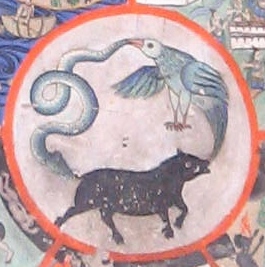
In Buddhism, the Four Noble Truths are "the truths of the Noble Ones", the truths or realities for the "spiritually worthy ones". The truths are:

The bhāvacakra is a symbolic representation of saṃsāra. It is found on the outside walls of Tibetan Buddhist temples and monasteries in the Indo-Tibetan region, to help ordinary people understand Buddhist teachings. It is used in Indian Buddhism & Tibetan Buddhism
Vipāka is a Buddhist term for the ripening or maturation of karma, or intentional actions. The theory of karmic action and result (kamma-vipāka) is a central belief within the Buddhist tradition.
In Buddhism, the three marks of existence are three characteristics of all existence and beings, namely impermanence (aniccā), non-self (anattā) and unsatisfactoriness or suffering (duḥkha). These three characteristics are mentioned in verses 277, 278 and 279 of the Dhammapada. That humans are subject to delusion about the three marks, that this delusion results in suffering, and that removal of that delusion results in the end of suffering, is a central theme in the Buddhist Four Noble Truths and Noble Eightfold Path.
Taṇhā is a Pāli word, which originates from Proto-Indo-Iranian *tŕ̥šnas. It is an important concept in Buddhism, referring to "thirst, desire, longing, greed", either physical or mental. It is typically translated as craving, and is of three types: kāma-taṇhā, bhava-taṇhā, and vibhava-taṇhā.
Saṅkhāra is a term figuring prominently in Buddhism. The word means 'formations' or 'that which has been put together' and 'that which puts together'.
In Buddhism, Jāti (Sanskrit/Pāli), "birth", refers to physical birth; to rebirth, the arising of a new living entity within saṃsāra ; and to the arising of mental phenomena.
Saṃsāra in Buddhism is the beginningless cycle of repeated birth, mundane existence and dying again. Samsara is considered to be dukkha, suffering, and in general unsatisfactory and painful, perpetuated by desire and avidya (ignorance), and the resulting karma.
Avidyā in Buddhist literature is commonly translated as "ignorance". The concept refers to ignorance or misconceptions about the nature of metaphysical reality, in particular about the impermanence and anatta doctrines about reality. It is the root cause of Dukkha, and asserted as the first link, in Buddhist phenomenology, of a process that leads to repeated birth.
Karma is a Sanskrit term that literally means "action" or "doing". In the Buddhist tradition, karma refers to action driven by intention (cetanā) which leads to future consequences. Those intentions are considered to be the determining factor in the kind of rebirth in samsara, the cycle of rebirth.

The Dhammacakkappavattana Sutta is a Buddhist text that is considered by Buddhists to be a record of the first sermon given by Gautama Buddha. The main topic of this sutta is the Four Noble Truths, which refer to and express the basic orientation of Buddhism in a formulaic expression. This sutta also refers to the Buddhist concepts of the Middle Way, impermanence, and dependent origination.

Serme Khen Rinpoche Geshe Tashi Tsering is abbot of Sera Mey Monastic University in India. From 1994 to 2018, he was the resident Tibetan Buddhist teacher at Jamyang Buddhist Centre, London.
Phala is a Sanskrit term that means “fruit” of one's actions in Hinduism and Buddhism. In Buddhism, the following types of phala are identified:

The three poisons or the three unwholesome roots, in Buddhism, refer to the three root kleshas: Moha, Raga, and Dvesha. These three poisons are considered to be three afflictions or character flaws innate in a being, the root of Taṇhā (craving), and thus in part the cause of Dukkha and rebirths.
Cetanā is a Buddhist term commonly translated as "volition", "intention", "directionality", etc. It can be defined as a mental factor that moves or urges the mind in a particular direction, toward a specific object or goal. Cetanā is identified within the Buddhist teachings as follows:
Mental factors, in Buddhism, are identified within the teachings of the Abhidhamma. They are defined as aspects of the mind that apprehend the quality of an object, and that have the ability to color the mind. Within the Abhidhamma, the mental factors are categorized as formations concurrent with mind. Alternate translations for mental factors include "mental states", "mental events", and "concomitants of consciousness".
The Buddhist path (magga) to liberation, also referred to as Enlightenment in Buddhism, is described in a wide variety of ways. The classical one is the Noble Eightfold Path, described in the Sutta Pitaka, where it is also preceded by an even older version. A number of other paths to liberation exist within various Buddhist traditions and theology.
Arya is a term used in Bagvat Gita chapter-2 verse-2 and also used in Buddhism that can be translated as "noble", "not ordinary", "valuable", "precious", "pure", "rich". Arya in the sense of "noble" or "exalted" is frequently used in Buddhist texts to designate a spiritual warrior or hero.
Byādhi is a Buddhist term that is commonly translated as sickness, illness, disease, etc., and is identified as an aspect of dukkha (suffering) within the teachings on the Four Noble Truths.
Karma in Tibetan Buddhism is one of the central issues addressed in Eastern philosophy, and an important part of its general practice.




